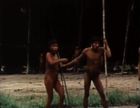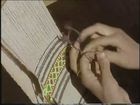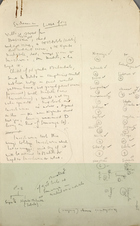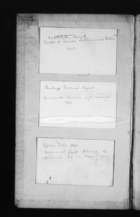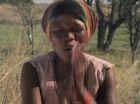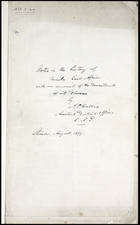Browse Titles - 14 results
The Ax Fight
written by Napoleon A. Chagnon, 1938-; directed by Timothy Asch, 1932-1994 and Napoleon A. Chagnon, 1938-; produced by Timothy Asch, 1932-1994 and Napoleon A. Chagnon, 1938- (Watertown, MA: Documentary Educational Resources (DER), 1975), 30 mins
A fight broke out in Mishimishimabowei-teri on the second day of Chagnon and Asch's stay in this village in 1971. The conflict developed between the villagers of Mishimishimabowei-teri and their visitors from another village. The visitors had formerly been part of Mishimishimabowei-teri, and many still had ties wi...
Sample
written by Napoleon A. Chagnon, 1938-; directed by Timothy Asch, 1932-1994 and Napoleon A. Chagnon, 1938-; produced by Timothy Asch, 1932-1994 and Napoleon A. Chagnon, 1938- (Watertown, MA: Documentary Educational Resources (DER), 1975), 30 mins
Description
A fight broke out in Mishimishimabowei-teri on the second day of Chagnon and Asch's stay in this village in 1971. The conflict developed between the villagers of Mishimishimabowei-teri and their visitors from another village. The visitors had formerly been part of Mishimishimabowei-teri, and many still had ties with members of that village. A fight broke out in Mishimishimabowei-teri on the second day of Chagnon and Asch's stay in this village in...
A fight broke out in Mishimishimabowei-teri on the second day of Chagnon and Asch's stay in this village in 1971. The conflict developed between the villagers of Mishimishimabowei-teri and their visitors from another village. The visitors had formerly been part of Mishimishimabowei-teri, and many still had ties with members of that village. A fight broke out in Mishimishimabowei-teri on the second day of Chagnon and Asch's stay in this village in 1971. The conflict developed between the villagers of Mishimishimabowei-teri and their visitors from another village. The visitors had formerly been part of Mishimishimabowei-teri, and many still had ties with members of that village. They refused to work in their hosts' gardens, yet they demanded to be fed. The event lasted about half an hour, ten minutes of which were filmed. The film is constructed of four parts. The first consists of an unedited version of what the cameraman saw and the sound technician recorded. The apparent chaos of these first ten minutes is clarified in the second section, in which Chagnon explains the sequence of actions, the relationships between the actors, and how the filmmakers' interpretation of the events became coherent. The third section diagrams the lineages in the villages involved to illustrate the fight's relationship to long-standing patterns of conflict and alliance within the village. Finally, in an edited version of the fight, we see how the editors' hands shape the "reality" we view. The Ax Fight thus operates on several levels. It plunges the viewer into the problems of Yanomamo kinship, alliance, and village fission; of violence and conflict resolution. At the same time it raises questions about how anthropologists and filmmakers translate their experience into meaningful words and coherent, moving images.
Show more
Show less
Date Written / Recorded
1971-02-28
Field of Study
Politics & Current Affairs
Content Type
Documentary
Contributor
Timothy Asch, 1932-1994, Napoleon A. Chagnon, 1938-, Craig Johnson
Author / Creator
Napoleon A. Chagnon, 1938-, Timothy Asch, 1932-1994
Date Published / Released
1975
Publisher
Documentary Educational Resources (DER)
Speaker / Narrator
Napoleon A. Chagnon, 1938-
Topic / Theme
Yanomamö, Politics, Negotiation in government, Kin relationships, Violence, Cultural identity, Rural population, Tribal and national groups, Indigenous peoples, Ethnography, Yanomámi
Copyright Message
copyright © Documentary Educational Resources
×
The Barabaig: East African Cattle Herders
written by George J. Klima (Long Grove, IL: Waveland Press, Inc., 1985, originally published 1970), 132 page(s)
Sample
written by George J. Klima (Long Grove, IL: Waveland Press, Inc., 1985, originally published 1970), 132 page(s)
Field of Study
Anthropology
Content Type
Ethnography
Contributor
George J. Klima
Author / Creator
George J. Klima
Date Published / Released
1970, 1985
Publisher
Waveland Press, Inc.
Topic / Theme
Datooga, Cattle, Cultural views, Tribal and national groups, Agrarian life
Copyright Message
Copyright © 1985 by Waveland Press
Sections
×
Chieftainship, Kinship, and the Kutu People, 1947
in Max Gluckman Papers, of Royal Anthropological Institute. Archives and Manuscripts (Box 19: Lozi Field Notes 1947, [Folder 1]) (1947) , 24 page(s)
Handwritten notes on lined paper containing information on chieftainship, Kutu people, wives, kinship, with the last several pages of notes crossed out.
Sample
in Max Gluckman Papers, of Royal Anthropological Institute. Archives and Manuscripts (Box 19: Lozi Field Notes 1947, [Folder 1]) (1947) , 24 page(s)
Description
Handwritten notes on lined paper containing information on chieftainship, Kutu people, wives, kinship, with the last several pages of notes crossed out.
Date Written / Recorded
1947
Field of Study
Anthropology
Content Type
Field notes
Contributor
Max Gluckman, 1911-1975
Author / Creator
Max Gluckman, 1911-1975
Topic / Theme
Tribal and national groups, Kinship nomenclature, Chieftains
Copyright Message
Material sourced from the Royal Anthropological Institute Archive. Copyright © 2016 by Royal Anthropological Institute
×
Cultural Identity and Ethnicity in the Pacific
edited by Lin Poyer, fl. 1990 and Jocelyn Linnekin, fl. 1990 (Honolulu, HI: University of Hawaii Press, 1990, originally published 1990), 340 page(s)
Cultural Identity and Ethinicity in the Pacific contributes a cultural perspective to ongoing scholarly debates about the nature of ethinicity. By investigating the range of cultural identities found in the modern Pacific, the authors raise provocative questions about the applicability of ethnicity as a scholarly...
Sample
edited by Lin Poyer, fl. 1990 and Jocelyn Linnekin, fl. 1990 (Honolulu, HI: University of Hawaii Press, 1990, originally published 1990), 340 page(s)
Description
Cultural Identity and Ethinicity in the Pacific contributes a cultural perspective to ongoing scholarly debates about the nature of ethinicity. By investigating the range of cultural identities found in the modern Pacific, the authors raise provocative questions about the applicability of ethnicity as a scholarly concept.
Field of Study
Anthropology
Content Type
Ethnography
Contributor
Lin Poyer, fl. 1990, Jocelyn Linnekin, fl. 1990
Date Published / Released
1990
Publisher
University of Hawaii Press
Topic / Theme
Societal structure, Racial identity, Cultural identity, Race and culture, Revitalization and ethnogenesis, Pacific Islanders
Copyright Message
Copyright ©1990 by University of Hawaii Press
×
Disappearing World, The Kalasha: Rites of Spring
directed by John Sheppard; produced by John Sheppard, in Disappearing World (London, England: Royal Anthropological Institute, 1990), 54 mins
The Kalasha are a tribal people, 3,000 strong, who live in the high valleys of the Hindu Kush mountains in the North West Frontier Province of Pakistan. The Kalasha are unique as a pagan people in this Islamic Republic.
Joshi, their three day festival of song and dance, rituals and sacrifice and the re-telling of...
Sample
directed by John Sheppard; produced by John Sheppard, in Disappearing World (London, England: Royal Anthropological Institute, 1990), 54 mins
Description
The Kalasha are a tribal people, 3,000 strong, who live in the high valleys of the Hindu Kush mountains in the North West Frontier Province of Pakistan. The Kalasha are unique as a pagan people in this Islamic Republic.
Joshi, their three day festival of song and dance, rituals and sacrifice and the re-telling of legends celebrates the coming of spring and encourages chivalrous romance between the sexes. All this provides a colourful focus for...
The Kalasha are a tribal people, 3,000 strong, who live in the high valleys of the Hindu Kush mountains in the North West Frontier Province of Pakistan. The Kalasha are unique as a pagan people in this Islamic Republic.
Joshi, their three day festival of song and dance, rituals and sacrifice and the re-telling of legends celebrates the coming of spring and encourages chivalrous romance between the sexes. All this provides a colourful focus for this film which explores the life and customs of the Kalasha. Before the menfolk depart to the high mountain pastures for the goats’ summer grazing they present the women with goats’ milk and bread that has been ritually purified. The women sing their thanks, praise and food and clamour for more. Whilst the men are away, the women stay in the narrow valleys, tending their tiny terraced fields of wheat, maize and millet. The Kalasha are worried that their way of life is under threat. The naively mortgaged land and walnut trees to their Chitrali Muslim neighbours, often in exchange for paltry loands. The Chitralis now covet the profits to be made from exploiting the cedar and holm oak which grow in the Kalasha valleys. The Pakistan government is aware of the problems and would like to safeguard the Kalashas’ existence as a flourishing minority culture and tourist industry. But a future as a ‘zoo people’ within a tourist park does not appeal to the Kalasha. They are happy to welcome tourists at their festivities and they appreciate interest in their customs, but they are pragmatic about its value to them.
Show more
Show less
Field of Study
Anthropology
Content Type
Documentary
Contributor
Peter Parkes, fl. 1990, John Sheppard
Author / Creator
John Sheppard, Peter Parkes, fl. 1990
Date Published / Released
1990
Publisher
Royal Anthropological Institute
Series
Disappearing World
Topic / Theme
Kalasha, Asian ethnic groups, Religious festivals, Kin groups, Elopement, Tribal and national groups, Indigenous peoples, Inuit
Copyright Message
Copyright © 1990 by the Royal Anthropological Institute
×
Handwritten Field Notes in Croxley Workbook, 1942
in Max Gluckman Papers, of Royal Anthropological Institute. Archives and Manuscripts (Box 3: Fieldnote Files 1940, [Folder 9]) (04 May 1942) , 10 page(s)
Date 5.4.1942. Handwritten notes and diagrams of family trees.
Sample
in Max Gluckman Papers, of Royal Anthropological Institute. Archives and Manuscripts (Box 3: Fieldnote Files 1940, [Folder 9]) (04 May 1942) , 10 page(s)
Description
Date 5.4.1942. Handwritten notes and diagrams of family trees.
Date Written / Recorded
04 May 1942, 1942
Field of Study
Anthropology
Content Type
Field notes
Contributor
Max Gluckman, 1911-1975
Author / Creator
Max Gluckman, 1911-1975
Topic / Theme
Family lineages, Tribal and national groups
Copyright Message
Material sourced from the Royal Anthropological Institute Archive. Copyright © 2016 by Royal Anthropological Institute
×
Handwritten Field Notes on the Mailu
in Bronislaw Malinowski Papers (Yale), of Yale University. Sterling Memorial Library. Manuscripts and Archives (Field Books Entitled "Hanuabada", Field book on the Mailu, with notes, kinship charts, native vocabulary, and diagrams by Malinowski) (New Haven, CT) (1916) , 16 page(s)
Field book on the Mailu, with notes, kinship charts, native vocabulary, and diagrams by Malinowski.
Sample
in Bronislaw Malinowski Papers (Yale), of Yale University. Sterling Memorial Library. Manuscripts and Archives (Field Books Entitled "Hanuabada", Field book on the Mailu, with notes, kinship charts, native vocabulary, and diagrams by Malinowski) (New Haven, CT) (1916) , 16 page(s)
Description
Field book on the Mailu, with notes, kinship charts, native vocabulary, and diagrams by Malinowski.
Date Written / Recorded
1916
Field of Study
Anthropology
Content Type
Field notes
Contributor
Bronisław Malinowski, 1884-1942
Author / Creator
Bronisław Malinowski, 1884-1942
Topic / Theme
Anthropological linguistics, Tribal and national groups, Island life, Kin groups, Motu
Copyright Message
Materials sourced from Yale University. Copyright © 2016 by Patrick Burke
×
Her Name Came on Arrows: A Kinship Interview with the Baruya of New Guinea
written by Allison Jablonko, 1936-, Marek Jablonko, 1927-2002 and Stephen Olsson; produced by Allison Jablonko, 1936-, Marek Jablonko, 1927-2002 and Stephen Olsson; interview by Maurice Godelier, 1934- (Watertown, MA: Documentary Educational Resources (DER), 1982), 26 mins
In the eastern highlands of Papua New Guinea, French anthropologist Maurice Godelier invites five of his Baruya friends and informants to his house to discuss Baruya kinship and rules of marriage. As Godelier poses questions, the kinship rules that provide the cohesive fabric of Baruya culture are brought to life.
Sample
written by Allison Jablonko, 1936-, Marek Jablonko, 1927-2002 and Stephen Olsson; produced by Allison Jablonko, 1936-, Marek Jablonko, 1927-2002 and Stephen Olsson; interview by Maurice Godelier, 1934- (Watertown, MA: Documentary Educational Resources (DER), 1982), 26 mins
Description
In the eastern highlands of Papua New Guinea, French anthropologist Maurice Godelier invites five of his Baruya friends and informants to his house to discuss Baruya kinship and rules of marriage. As Godelier poses questions, the kinship rules that provide the cohesive fabric of Baruya culture are brought to life. In the eastern highlands of Papua New Guinea, French anthropologist Maurice Godelier invites five of his Baruya friends and informants...
In the eastern highlands of Papua New Guinea, French anthropologist Maurice Godelier invites five of his Baruya friends and informants to his house to discuss Baruya kinship and rules of marriage. As Godelier poses questions, the kinship rules that provide the cohesive fabric of Baruya culture are brought to life. In the eastern highlands of Papua New Guinea, French anthropologist Maurice Godelier invites five of his Baruya friends and informants to his house to discuss Baruya kinship and rules of marriage. As Godelier poses questions, the kinship rules that provide the cohesive fabric of Baruya culture are brought to life. Abstract terms are given practical meanings as Godelier investigates Baruya customs of stealing wives, exchanging sisters for wives, stealing names and exchanging 'food for blood.'
Show more
Show less
Field of Study
Politics & Current Affairs
Content Type
Interview
Contributor
Allison Jablonko, 1936-, Marek Jablonko, 1927-2002, Stephen Olsson, Maurice Godelier, 1934-, Kandavatche, Djirinac, Gwataie
Author / Creator
Allison Jablonko, 1936-, Marek Jablonko, 1927-2002, Stephen Olsson, Maurice Godelier, 1934-
Date Published / Released
1982
Publisher
Documentary Educational Resources (DER)
Person Discussed
Kandavatche, Djirinac, Gwataie
Topic / Theme
Baruya, Cultural identity, Kin relationships, Marriage, Family, Tribal and national groups, Ethnography
Copyright Message
© Documentary Educational Resources
×
!Kung, N!ai, The Story of a !Kung Woman
written by John Marshall, 1932-2005; directed by John Marshall, 1932-2005; produced by John Marshall, 1932-2005, in !Kung (Documentary Educational Resources (DER)), 58 mins
This film provides a broad overview of Ju/'hoan life, both past and present, and an intimate portrait of N!ai, a Ju/'hoan woman who in 1978 was in her mid-thirties.
Sample
written by John Marshall, 1932-2005; directed by John Marshall, 1932-2005; produced by John Marshall, 1932-2005, in !Kung (Documentary Educational Resources (DER)), 58 mins
Description
This film provides a broad overview of Ju/'hoan life, both past and present, and an intimate portrait of N!ai, a Ju/'hoan woman who in 1978 was in her mid-thirties. This film provides a broad overview of Ju/'hoan life, both past and present, and an intimate portrait of N!ai, a Ju/'hoan woman who in 1978 was in her mid-thirties. N!ai tells her own story, and in so doing, the story of Ju/'hoan life over a thirty year period. "Before the white peop...
This film provides a broad overview of Ju/'hoan life, both past and present, and an intimate portrait of N!ai, a Ju/'hoan woman who in 1978 was in her mid-thirties. This film provides a broad overview of Ju/'hoan life, both past and present, and an intimate portrait of N!ai, a Ju/'hoan woman who in 1978 was in her mid-thirties. N!ai tells her own story, and in so doing, the story of Ju/'hoan life over a thirty year period. "Before the white people came we did what we wanted," N!ai recalls, describing the life she remembers as a child: following her mother to pick berries, roots, and nuts as the season changed; the division of giraffe meat; the kinds of rain; her resistance to her marriage to /Gunda at the age of eight; and her changing feelings about her husband when he becomes a healer. As N!ai speaks, the film presents scenes from the 1950's that show her as a young girl and a young wife. The uniqueness of N!ai may lie in its tight integration of ethnography and history. While it portrays the changes in Ju/'hoan society over thirty years, it never loses sight of the individual, N!ai.
Show more
Show less
Field of Study
Anthropology
Content Type
Documentary
Contributor
John Marshall, 1932-2005, Kunta Boo, N!ae Kommtsa
Author / Creator
John Marshall, 1932-2005
Date Published / Released
1980
Publisher
Documentary Educational Resources (DER)
Series
!Kung
Person Discussed
N!ae Kommtsa
Topic / Theme
Ju/'hoansi, !Kung, Kin relationships, Communities, Cultural change and history, Cultural identity, Women, Tribal and national groups, Daily life, Ethnography, Ju❘’hoan
Copyright Message
© Documentary Educational Resources
×
Notes from Sir Alfred Claud Hollis on History of Vumba, East Africa
written by Sir Alfred Claud Hollis, 1874-1961, in Hollis, Sir Alfred Claud, of Royal Anthropological Institute. Archives and Manuscripts (1899) , 92 page(s)
Sample
written by Sir Alfred Claud Hollis, 1874-1961, in Hollis, Sir Alfred Claud, of Royal Anthropological Institute. Archives and Manuscripts (1899) , 92 page(s)
Date Written / Recorded
1899
Field of Study
Anthropology
Content Type
Ethnography
Contributor
Sir Alfred Claud Hollis, 1874-1961
Author / Creator
Sir Alfred Claud Hollis, 1874-1961
Topic / Theme
East African, Family lineages, Family relationships, Tribal and national groups
×

